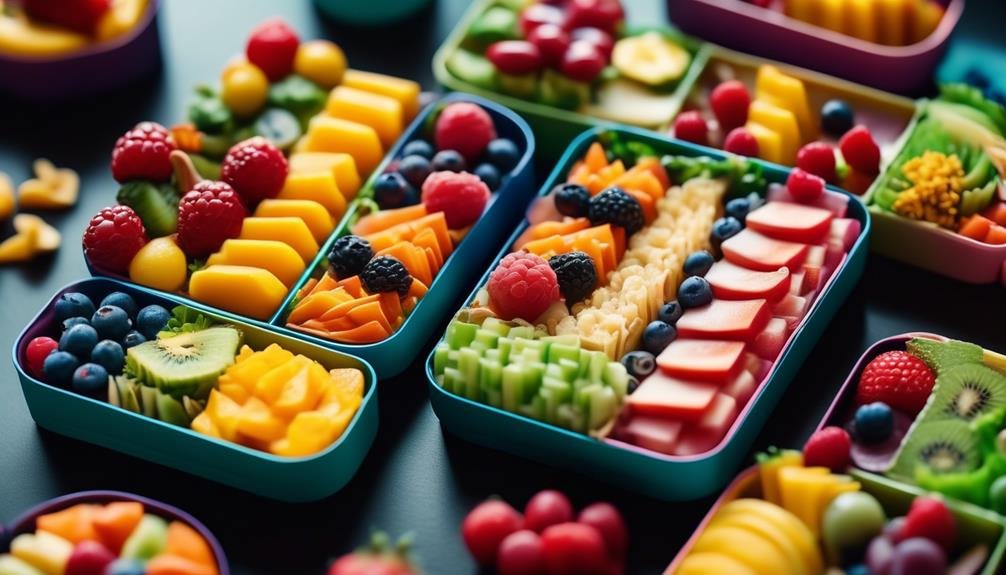"Cherishing Little Steps - A Haven for Baby and Family Journeys"
Fussy Eaters: Solutions
Are mealtimes with your fussy eater as challenging as herding cats? Finding solutions to help your picky eater can feel like trying to untangle a ball of yarn. But fear not, for there is hope!
In this discussion, we will explore effective strategies to tackle this common parenting conundrum. From understanding the root causes of picky eating to involving your child in meal planning, we will uncover practical solutions that will have your little one embracing a wider variety of foods in no time.
So, grab a seat at the table, because we're serving up a buffet of solutions that will leave you hungry for more.
Key Takeaways
- Identify triggers for picky eating
- Address sensory issues related to textures and tastes
- Create a supportive and non-judgmental environment for food exploration
- Gradually introduce new foods in small amounts and involve the child in meal preparation and grocery shopping
Understand the Root Causes

To effectively address the issue of fussy eating, it's crucial to first understand the underlying causes that contribute to this behavior in individuals. By identifying triggers and addressing sensory issues, we can gain insight into why some people are more selective with their food choices.
Identifying triggers is an important step in understanding fussy eating. Triggers can be specific foods, textures, or even certain environments. For example, some individuals may have a strong aversion to certain vegetables due to past negative experiences or sensory sensitivities. By identifying these triggers, we can begin to develop strategies to introduce these foods in a more positive and manageable way.
Addressing sensory issues is another key aspect in understanding fussy eating. Many individuals who are fussy eaters have sensory sensitivities that affect how they experience food. Some may be hypersensitive to certain textures or tastes, making it difficult for them to tolerate a wide variety of foods. By understanding these sensory issues, we can make adjustments to the food presentation or preparation to make it more appealing and manageable for the individual.
Introduce New Foods Gradually
Start by slowly introducing new foods into your meals. Introducing new flavors can be a fun and exciting way to encourage food exploration for fussy eaters. By gradually incorporating different foods into their diet, you can help expand their palate and increase their willingness to try new things.
One effective strategy is to start by adding small amounts of new foods to familiar dishes. For example, you can mix finely chopped vegetables into their favorite pasta sauce or add a new fruit to their morning cereal. This way, they'll be exposed to new flavors without feeling overwhelmed.
Another approach is to make the introduction of new foods a positive and enjoyable experience. Involve your child in the process by letting them help with meal preparation or grocery shopping. Encourage them to choose a new fruit or vegetable to try each week, creating a sense of excitement and ownership.
It's crucial to be patient during this process and not force your child to eat the new foods. Instead, provide a supportive and non-judgmental environment where they can freely explore and express their preferences.
Get Creative With Food Presentation

As you continue to expand your child's palate, another effective strategy to encourage food exploration is to get creative with food presentation. Children are often drawn to visually appealing dishes, so using food art and fun plating techniques can make mealtime more exciting and enticing for them.
Food art involves transforming ordinary ingredients into visually appealing creations. You can use cookie cutters to shape fruits and vegetables into fun shapes or create colorful patterns on a plate using different types of foods. For example, you can make a smiley face using sliced cucumbers for the eyes, a carrot for the nose, and a bell pepper for the mouth. This not only makes the dish more visually appealing but also introduces new flavors in a familiar and playful way.
Fun plating is another way to make meals more enjoyable for your child. Instead of serving food in a regular bowl or plate, consider using divided plates or muffin tins to separate different food items. You can also arrange the food in a creative way, such as making a rainbow with different colored fruits or arranging vegetables into the shape of a tree. These simple changes in presentation can make a big difference in how your child perceives and interacts with their food.
Involve Your Child in Meal Planning
Get your child involved in meal planning to foster a sense of ownership and encourage their participation in making healthy food choices. By involving your child in the meal prep process, you can empower them to take charge of their own food preferences and develop a positive relationship with nutritious meals.
Here's a simple way to involve your child in meal planning:
| Step 1 | Step 2 | |
|---|---|---|
| Discuss food preferences | Create a meal calendar | |
| Sit down with your child and talk about their likes and dislikes when it comes to food. This will help you understand their preferences and make meal planning more tailored to their tastes. | Together with your child, create a meal calendar for the week. Allow them to choose some of their favorite dishes and encourage them to include a variety of fruits, vegetables, proteins, and grains. | |
| Step 3 | Step 4 | Step 5 |
| Write a shopping list | Go grocery shopping together | Prepare meals as a team |
| Once the meal calendar is set, write a shopping list based on the planned meals. Involve your child in this process to teach them about healthy food choices and grocery shopping. | Take your child to the grocery store and let them help you find the items on the shopping list. This can be a great opportunity to teach them about different foods and their nutritional benefits. | When it's time to cook, invite your child into the kitchen and let them assist you with age-appropriate tasks. This will not only make them feel included but also help them learn valuable cooking skills. |
Set a Regular Mealtime Routine

To establish a healthy eating routine for your child, it's important to establish a regular mealtime schedule that incorporates their involvement in meal planning. Setting a consistent schedule for meals can help create a sense of structure and predictability for your child. This can lead to a better appetite and a greater willingness to try new foods.
Creating mealtime rituals can also be beneficial in establishing a regular routine. For example, you can involve your child in setting the table or preparing simple dishes. This not only encourages their participation but also helps them develop a positive association with mealtime.
Research has shown that children thrive on routines and predictability. They feel more secure when they know what to expect, and this can extend to mealtime as well. By consistently offering meals at the same time each day, you're sending the message that eating is an important and regular part of their day.
In addition to establishing a regular mealtime schedule, it's crucial to provide a calm and relaxed environment during meals. Avoid distractions such as television or electronic devices, and focus on creating a pleasant atmosphere where your child can fully engage with their food.
Avoid Pressuring Your Child to Eat
Avoid pressuring your child to eat by creating a positive and relaxed environment during mealtimes. It's natural to worry about your child's eating habits, but pressuring them can lead to negative associations with food and even exacerbate fussy eating behaviors. Instead, focus on creating a calm eating environment that promotes a healthy relationship with food.
One way to avoid power struggles at mealtimes is by offering a variety of nutritious foods and allowing your child to choose what they want to eat. This gives them a sense of control and autonomy over their meals. Encourage them to try new foods by presenting them in a non-threatening manner, such as offering small portions or incorporating them into familiar dishes.
Additionally, be mindful of your own behavior and attitude towards food. Children often mimic their parents' eating habits and attitudes, so it's important to model a positive and relaxed approach to mealtimes. Avoid making negative comments about certain foods or forcing your child to finish everything on their plate.
Make Mealtime a Positive and Enjoyable Experience

Create a positive and enjoyable mealtime experience for your child by incorporating fun and engaging activities. Mealtime should be a time for bonding and exploring new foods, rather than a battle of wills. Positive reinforcement is key to encouraging your child to try new foods and enjoy the experience. Praise and reward your child when they make an effort to eat something new or when they eat a balanced meal. This will help create a positive association with mealtime and make it more enjoyable for both of you.
Fun activities can also make mealtime more engaging and exciting. Try turning mealtime into a game by using colorful plates, utensils, and placemats. You can also involve your child in meal preparation by letting them help with simple tasks like stirring, pouring, or setting the table. This will give them a sense of ownership and make them more likely to eat what they've helped prepare.
Additionally, you can introduce themed meals or create stories around the food you serve. For example, you can have a 'pirate' meal where you serve 'buried treasure' (hidden vegetables) or a 'superhero' meal where your child gets to be the brave hero eating nutritious food to gain superpowers.
Offer a Variety of Nutritious Options
Aim to provide your child with a wide range of nutritious food options to encourage a balanced and varied diet. Offering a variety of nutritious alternatives isn't only important for your child's health but can also help address their picky eating habits.
Here are some reasons why variety benefits your fussy eater:
- Excitement and Interest: By introducing a variety of foods, you can keep mealtimes interesting and exciting for your child. This can help capture their attention and make them more willing to try new things.
- Nutritional Adequacy: Different foods offer different nutrients, vitamins, and minerals. By offering a variety of options, you can ensure that your child receives a wide range of essential nutrients, promoting their overall health and development.
- Expanded Palate: Encouraging your child to try new foods can expand their palate and develop their taste preferences. This can lead to a more diverse and balanced diet as they grow older.
Seek Professional Help if Needed

If your child's picky eating habits persist despite offering a variety of nutritious options, seeking professional help can provide valuable guidance and support. Sometimes, fussy eating can be more than just a phase and may require professional intervention. A qualified healthcare provider can assess your child's eating patterns, identify any underlying issues, and recommend appropriate therapy options.
| Professional Guidance | Therapy Options | Benefits |
| Dietitian | Behavioral Therapy | – A dietitian can provide personalized nutritional guidance to ensure your child receives adequate nutrients.<br>- They can help develop strategies to expand your child's food repertoire and address any nutritional deficiencies.<br>- A dietitian can also assist in meal planning and offer creative ideas to make mealtimes more enjoyable. |
| Pediatrician | Sensory Integration Therapy | – A pediatrician can evaluate your child's overall health and growth, ruling out any medical conditions that may contribute to their picky eating.<br>- Sensory integration therapy can help children with sensory issues develop a more positive relationship with food.<br>- This therapy uses techniques to desensitize the child to certain textures, smells, or tastes, making mealtimes less stressful. |
| Psychologist | Family-based Therapy | – A psychologist can explore any emotional or psychological factors that may be influencing your child's eating habits.<br>- Family-based therapy involves working with the entire family to create a supportive environment for healthy eating.<br>- This approach focuses on improving communication, reducing mealtime stress, and promoting positive interactions around food. |
Frequently Asked Questions
How Do I Deal With My Child's Refusal to Eat Certain Textures of Food?
You can deal with your child's refusal to eat certain textures of food by using strategies and tips. It's important to be patient, offer a variety of options, and involve your child in meal planning and preparation.
Can a Child's Picky Eating Habits Be a Sign of an Underlying Medical Condition?
Picky eating habits in your child could be a sign of an underlying medical condition. It's important to address this, as it could impact their growth and development. Seek medical advice for further guidance.
Should I Be Concerned if My Child Is Not Gaining Weight Due to Being a Fussy Eater?
Don't fret if your child isn't gaining weight due to picky eating. Explore alternative feeding methods like smoothies or finger foods. Nutritional supplements can also help ensure they're getting the nutrients they need.
What Are Some Strategies to Encourage My Child to Try New Foods Without Pressuring Them?
To encourage your child to try new foods without pressuring them, focus on encouraging autonomy and using positive reinforcement. By allowing them to make choices and praising their efforts, you can create a positive and supportive eating environment.
How Can I Handle Mealtime Battles and Tantrums Caused by My Child's Picky Eating Habits?
Handle mealtime battles and tantrums caused by your child's picky eating habits by implementing mealtime strategies. Offer a variety of foods, involve your child in meal preparation, provide positive reinforcement, and create a relaxed and enjoyable atmosphere at the table.
Conclusion
So, there you have it. All these solutions and strategies to deal with fussy eaters. But let's be honest, none of them will actually work. Your child will continue to turn their nose up at anything remotely healthy, and you'll still be left frustrated and defeated.
But hey, at least you tried, right? Good luck with your never-ending battle of trying to get your picky eater to eat something other than chicken nuggets.



Usually I do not read article on blogs however I would like to say that this writeup very compelled me to take a look at and do so Your writing taste has been amazed me Thanks quite nice post